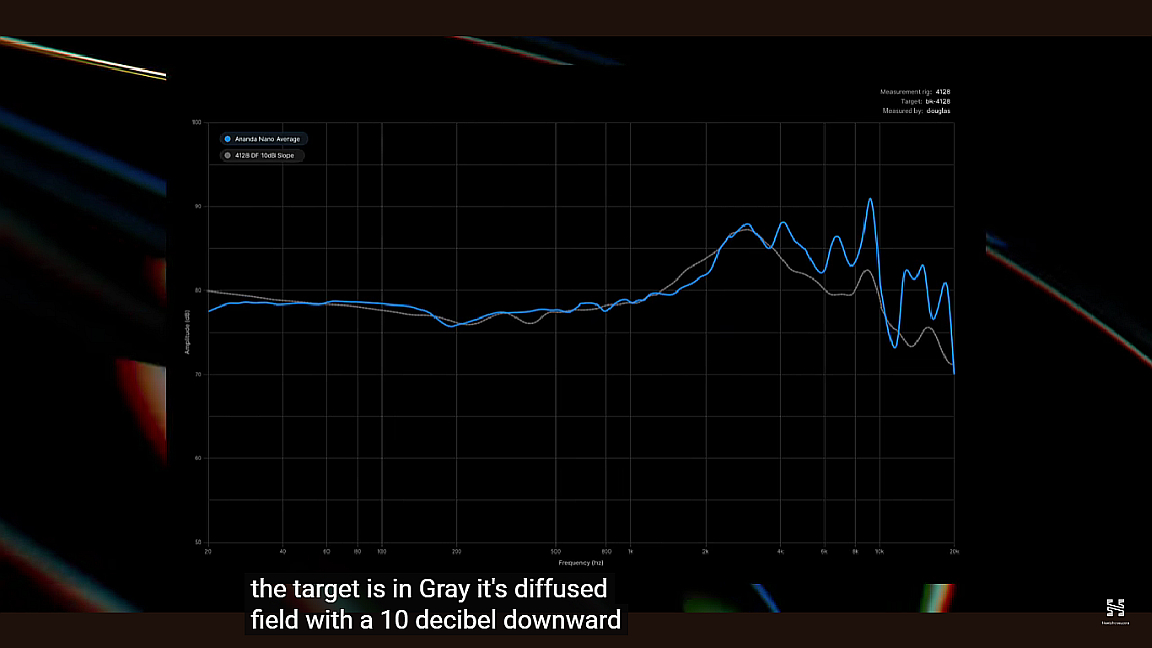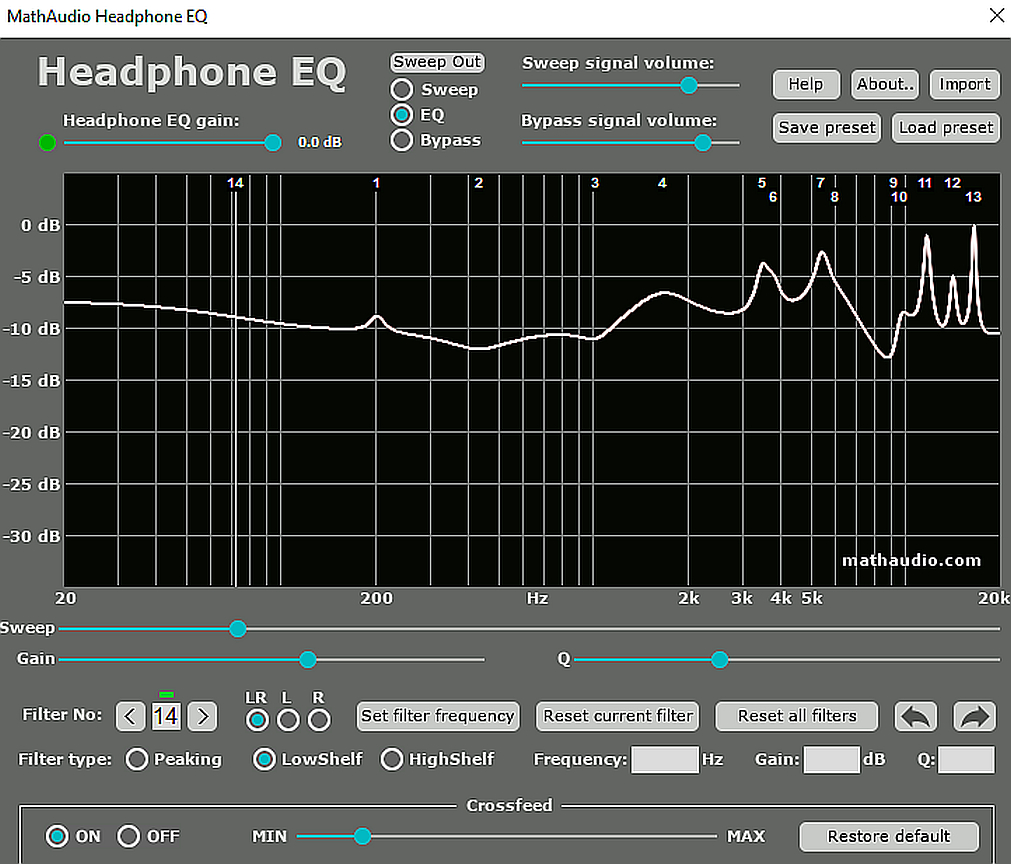Tuning my HiFiMan Ananda Nano headphones. These new Superlight diaphragm planar headphones can be ultra revealing but tend to come with several break up modes which benefit from EQ. I'm using the excellent Math Audio Headphone EQ plugin for Parametric EQ and Headphone Crossfeed with Foobar as a player which also allows easy application of a WASAPI exclusive plugin to eliminate any involvement of the Windows Kernel Mixer and it's sonic degradation so I can pass HiRez PCM out the USB.
https://www.foobar2000.org/components/view/foo_headphone_eq
https://www.foobar2000.org/components/view/foo_out_wasapi
The MiniDSP EARS measurement jig is USB plug and play and measures with serial number specific cal files including compensation for the mics and its intrinsic 4.3kHz canal resonance, superimposed with the Harmon curve. A gated sine wave sweep is output via the excellent Room EQ Wizard software through your playback hardware and captured again by REW .

https://www.minidsp.com/products/acoustic-measurement/ears-headphone-jig
https://www.roomeqwizard.com/
Here is the resulting measurement of the Ananda Nano showing the corrected for my jig Harmon curve in the middle and the deviation of the Nanos from the curve at the top.

The measured frequency response deviation is shown above. The EARS HEQ curve in the middle is the target and the frequency response at the top would appear flat if there were no deviation from the curve which as you can see incorporates a Harmon curve with additional EARS response correction for the 4.3kHz Helmholtz resonance of the cylindrical "canal" of the unit leading in to the mics, and the serial number specific mic cals all superimposed.
The EQ section of Room EQ Wizard will then allow auto EQ of up to 20 filters, and display the predicted resulting frequency response deviations as referenced to the calibration curve that was used to create the preceding measurement.

And predicted phase deviations from the cal curve after EQ

I then type the filters into Math Audio. As for my particular Nanos and EARS

The composite correction looks like this. Disregard the 20kHz rise which I can manually chop down.

I always find the Harmon curve (and flat quasi anechoic loudspeakers) to be dim on top so to bring back the skin and cymbal strike of drum kit I then go through the graphic EQ that is built in to Foobar to fine tune for preference. I wish Math Audio had a tab to overlay an 8/16/32 band Graphic EQ screen right in that app to avoid having multiple things running.

There may be some contribution to my preference for some added highs due to the Sparkos Pro op amps that I have fitted to my Burson Conductor Reference SE which tend to be a bit polite on top compared to the Burson Vivid op amps or OPA1656. But the transparency and fine detail and power in the bass of the Sparkos Pros is unmatched. I compared them again to the stock Conductor 3XP with Vivids (I had a set of Sparkos Pro in that unit first but they don't fit under the lower case lid so stole them for the Reference which has a taller case and plan to make a new set for the 3XP without the adapter boards to get them to fit) and just as quickly unplugged from it.

The HiFiMan Ananda Nanos are a bargain at $600 and can be elevated to an entirely new league with some EQ where they then show the best of the impressive fine detail that an ultra light planar film can provide.
https://hifiman.com/products/detail/334
https://www.foobar2000.org/components/view/foo_headphone_eq
https://www.foobar2000.org/components/view/foo_out_wasapi
The MiniDSP EARS measurement jig is USB plug and play and measures with serial number specific cal files including compensation for the mics and its intrinsic 4.3kHz canal resonance, superimposed with the Harmon curve. A gated sine wave sweep is output via the excellent Room EQ Wizard software through your playback hardware and captured again by REW .

https://www.minidsp.com/products/acoustic-measurement/ears-headphone-jig
https://www.roomeqwizard.com/
Here is the resulting measurement of the Ananda Nano showing the corrected for my jig Harmon curve in the middle and the deviation of the Nanos from the curve at the top.

The measured frequency response deviation is shown above. The EARS HEQ curve in the middle is the target and the frequency response at the top would appear flat if there were no deviation from the curve which as you can see incorporates a Harmon curve with additional EARS response correction for the 4.3kHz Helmholtz resonance of the cylindrical "canal" of the unit leading in to the mics, and the serial number specific mic cals all superimposed.
The EQ section of Room EQ Wizard will then allow auto EQ of up to 20 filters, and display the predicted resulting frequency response deviations as referenced to the calibration curve that was used to create the preceding measurement.

And predicted phase deviations from the cal curve after EQ

I then type the filters into Math Audio. As for my particular Nanos and EARS

The composite correction looks like this. Disregard the 20kHz rise which I can manually chop down.

I always find the Harmon curve (and flat quasi anechoic loudspeakers) to be dim on top so to bring back the skin and cymbal strike of drum kit I then go through the graphic EQ that is built in to Foobar to fine tune for preference. I wish Math Audio had a tab to overlay an 8/16/32 band Graphic EQ screen right in that app to avoid having multiple things running.

There may be some contribution to my preference for some added highs due to the Sparkos Pro op amps that I have fitted to my Burson Conductor Reference SE which tend to be a bit polite on top compared to the Burson Vivid op amps or OPA1656. But the transparency and fine detail and power in the bass of the Sparkos Pros is unmatched. I compared them again to the stock Conductor 3XP with Vivids (I had a set of Sparkos Pro in that unit first but they don't fit under the lower case lid so stole them for the Reference which has a taller case and plan to make a new set for the 3XP without the adapter boards to get them to fit) and just as quickly unplugged from it.

The HiFiMan Ananda Nanos are a bargain at $600 and can be elevated to an entirely new league with some EQ where they then show the best of the impressive fine detail that an ultra light planar film can provide.
https://hifiman.com/products/detail/334
Last edited:









































